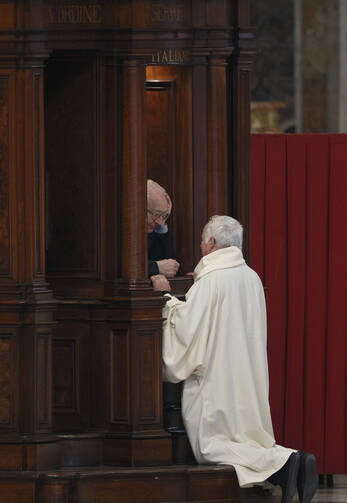Sacred Silence
Everyone knows—or should know—that a priest cannot break the confessional seal. Canon law is clear on this point. Some have argued that the person making a confession can waive his or her right to confidentiality and thus release the priest from his obligation. That question might soon reach the U.S. Supreme Court.
In Baton Rouge, La., a 16-year-old girl filed a suit against the local diocese claiming that she told her confessor that she was being abused by a lay parishioner when she was 14 and that the priest told her to “sweep it under the floor and get rid of it.” The girl has waived her right to confidentiality so that the priest might be free to testify. The diocese maintains that the state should not use its power to gain access to a conversation between a penitent and a priest during confession. The initial lawsuit was thrown out by the appellate court in Louisiana, but that decision was overturned by the state supreme court. The diocese has petitioned the U.S. Supreme Court for review.
In a blog post for The Jesuit Post channel on Patheos, Sam Sawyer, S.J., pointed to the complexities of the case. The priest has a duty to protect the right to secrecy of an individual penitent, he explained, but his duty goes further: to protect the integrity of sacramental confession itself for the benefit of all penitents. No individual penitent can relieve the confessor from this dimension of his obligation to secrecy. But a priest/confessor can help an abuse victim in other ways: by encouraging the penitent, for example, to report the abuse outside the bounds of the sacrament.
Peace Now? How?
When Adolfo Nicolás, S.J., superior general of the Society of Jesus, wrote to Jesuit provincial superiors and other advisers throughout the world about the main challenge of our time, he spoke in the spirit of Pope Francis. What, he asked, can the Society do for peace? The answers flooded in, and his reply letter to all 16,000 Jesuits worldwide was a challenge to think, pray and act.
Pope Francis recently told a crowd at an Italian war memorial, “War is madness” and said it seemed as if World War III were already being fought in a “piecemeal” fashion around the globe. A dangerous confrontation between the West and Russia simmers in Ukraine. The bombed ruins of Gaza smolder, and in Iraq ISIS tortures and kills Muslims and Christians alike with impunity.
In 1973 Father General Pedro Arrupe told his fellow Jesuits that some of them might die living a “faith that does justice.” Sixteen years later, six Jesuits, their housekeeper and her daughter were murdered in the midst of El Salvador’s civil war. Last April Frans van der Lugt, S.J., was shot in the head in front of his home in Homs, Syria, where he had served the people as a psychotherapist and pastor for 48 years. Throughout the 20th century, in persecutions, world wars, concentration camps and violent social movements, over 300 Jesuits met death.
The letter from Father Nicholás challenged Jesuit schools to “take the risk of being wounded as Jesus was” and develop interdisciplinary programs that instill spirituality and forgiveness. But first, he said, Jesuits must achieve “reconciliation among ourselves.” Only then can the Society become a “prophetic institution that denounces the injustices that produce violence,” even unto death.
Black Lung Returns
“Black lung, black lung, oh you’re just biding your time,” we have been warned in song. It appears black lung’s time—incredibly—has come again.
The worst form of the coal miner’s disease—progressive fibrosis, a torturous, incurable condition—has come roaring back after being essentially eliminated in the 1990s. The danger of black lung has been known for decades; it has stolen the lives of 76,000 miners since 1968. But the means for preventing it, dust suppression and air filtering systems, have also been well known, and they were effective.
Just 15 years ago, the prevalence of this most serious form of black lung among miners with at least 25 years of service had been reduced to just 0.33 percent. But by 2012, according to a recent report from the National Institute for Occupational Safety and Health, black lung among such longtime miners shot up ten-fold to 3.23 percent, the highest level since the early 1970s. The study’s authors blame the spike on overexposure to dust and increased toxicity stemming from changes in dust composition. New techniques for coal extraction are reaching smaller coal seams through thicker layers of rock that throw out new combinations of toxic silica.
Sadly the current percentage of affected miners will surely creep higher; because of the disease’s long latency period many of today’s working miners do not know how sick they are. And it will likewise be years before the effectiveness of any new effort to combat black lung will be clear. That is all the more reason to accelerate the response to this health emergency, but mining concerns are battling government regulators over new standards for dust control. The inexcusable resurgence of black lung should be all the argument needed to immediately beef up worker protections and regulatory surveillance.








